Matador Network's Blog, page 1174
January 28, 2019
Game of Thrones hedges lose a tree

Fans of the series Game of Thrones will shed a tear today for the loss of one of the trees that form the picturesque Dark Hedges, also known as “the Kingsroad.”
The Dark Hedges are a incredible beech tree tunnel on Bregagh Road in Ballymoney, Northern Ireland, that have become popular with tourists since being used as a filming location for Game of Thrones. 60 mph winds felled the tree on Saturday, though several of the other trees had been damaged in previous storms.
Originally, the trees were planted by the Stuart family along the entrance to their Gracehill House mansion back in 1775. Through the centuries, the branches began to bend over the road, eventually intertwining with one another, creating a surreal covered passageway.
There were 150 trees at first, but due to time and weather, that number stands at about 90. The Woodland Trust’s Paddy Cregg told BBC News that by beech tree standards, the remaining trees are “old aged pensioners.” He also explained that, “They are coming to the end of their life, normally beech trees survive around 250 years, they are probably now 240 years old.”
Fans of the TV fantasy drama better make their way to beautiful Northern Ireland soon if they want to be able to witness this spectacular, but ephemeral, natural phenomenon. 
H/T: BBC News

More like this: 23 real-life settings you can visit from Game of Thrones
The post ‘Game of Thrones’ Dark Hedges lose one tree in wind storm appeared first on Matador Network.

Cool street art in India

Residents of Panjim, in the state of Goa in southwest India don’t need to venture very far to get their daily dose of art and philosophy. A new art installation by DAKU, a street artist, is taking over a street in Panjim, and it’s forcing people to stop and contemplate the passage of time. The piece, entitled “Theory of Time,” features a net of letters suspended above the entire street that casts a shadow on the ground below, forming phrases about the concept of time, such as “Time works wonders” and “Things take time.”
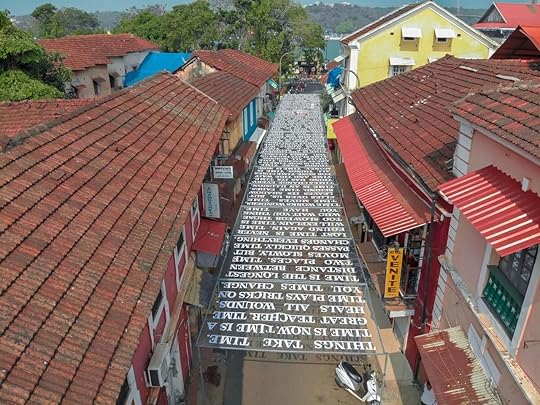
Photo: St+art India/Facebook
Because the installation relies on sunlight, the shadow letters appear and change with the rotation of the Earth, making the piece not only playful but even more meaningful in its interpretation of time.

Photo: St+art India/Facebook
Viewers can immerse themselves in the beauty of the installation by walking underneath the net, standing among the shadow letters on the ground, and contemplating the variety of phrases.

Photo: St+art India/Facebook
The project is supported by the nonprofit St+art India, as part of the Serendipity Arts Festival. 
H/T: My Modern Met

More like this: The 9 best street art cities in the world
The post This trippy street art installation in India changes with the passage of time appeared first on Matador Network.

What is the “Pool of Arches”
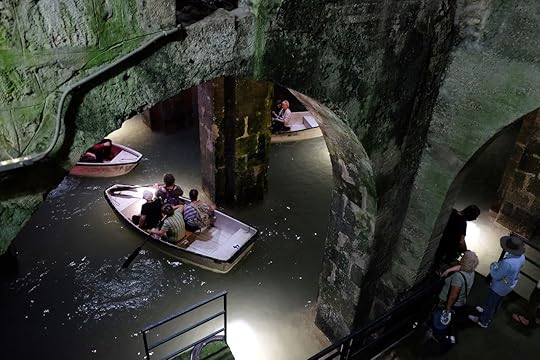
It might be darker and damper than the canals of Venice, but at least you can avoid the crowds on this boat ride. The “Pool of Arches” in Ramla, Israel, an underground roofed water reservoir dating back to the eighth century, is open to the public.

Photo: Walkabout Photo Guides/Shutterstock
Despite earthquake damage to other parts of Ramla during the past 1,200 years, the “Pool of Arches” is still in excellent condition. According to the pool’s website, the structure stands as “a rare witness to the quality of construction and beauty of Muslim architecture.”
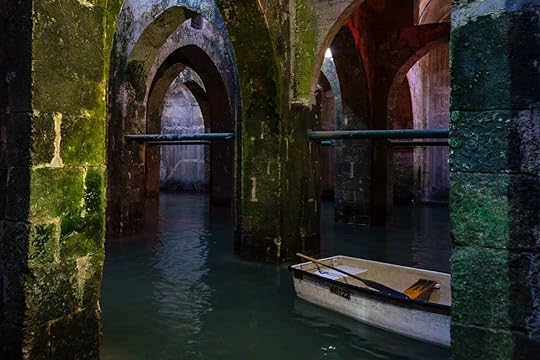
Photo: Walkabout Photo Guides/Shutterstock
To take the journey through the underground arches, visitors must descend a staircase to one of the pool’s row boats. The pool itself is 65 feet by 69 feet, contains 15 columns with curved arches that support the roof square, and has an inscription from the reservoir’s construction in 789 AD. Cut into the roof are square hatches where people used to lower buckets to collect water. The reservoir also goes by the Arabic name “Pool of Goats,” for the goats that used to drink from it.
The reservoir is open Sunday to Friday, and it costs about $3 for a guided tour. 
H/T: Travel & Leisure

More like this: Why Dubai is the best trip to dip your toes in Arab culture
The post Take an epic boat ride through this ancient underground pool in Israel appeared first on Matador Network.

January 25, 2019
Best golf tournaments in the US

I am not a golf person. Like most people, I can name Tiger Woods, but no way in hell I can tell you who won the Masters.
What I am a fan of is a good party, and even though I can’t name 99 percent of the PGA Tour, I can with complete confidence tell you that good golf tournaments are the best spectator experience in sports. What’s that you say? How could a game that’s about as action-packed as lunch at the senior center be the best sport to attend? Easy. Because the PGA Tour knows it doesn’t have bone-crushing tackles or fast-break dunks, it’s made some tournaments week-long parties, complete with free-flowing booze, gourmet food, star-studded concerts, and viewing areas mere feet from the players.
The Waste Management Open in Phoenix is like spring break on a golf course. The Safeway Open in Napa is effectively a wine and food festival. The Zurich Classic in New Orleans lets you eat around the city without the festive aroma of Bourbon Street. All of it with literally the top golfers in the world putting within selfie distance. If this has you hyped to go to a golf tournament this year, here are my selections for the top eight.
Safeway Open — Napa, California; October 1-7

Photo: Safeway Open/Facebook
Right as harvest season concludes, the Silverado Resort and Spa hosts this annual event where over 60 wine, beer, and spirit purveyors line the course, offering spectators the chance to have a full-on Napa wine-tasting weekend without ever leaving. You won’t even have to rush off to make your 8:00 PM reservation at French Laundry since in past years Thomas Keller — along with Charlie Palmer, Masaharu Morimoto, and other famous chefs — have handled the food duties. Once you’ve spent the day gorging on gourmet food and fine Napa wine, an evening concert series wraps up each night, this year headlined by Young the Giant, Billy Idol, and Sammy Hagar.
Waste Management Phoenix Open — Scottsdale, Arizona; February 28-March 3

Photo: WM Phoenix Open/Facebook
If the refined, genteel PGA Tour has its version of the infield at the Kentucky Derby, it’s the Waste Management Open. And we should expect nothing less from a tournament named after a garbage truck. The late-winter tourney not-so-coincidentally coincides with spring break, and the atmosphere around the course can sometimes feel like a weekend in Cabo with more clothes. Usually. The biggest party of the weekend can be found on the 16th hole, which boasts stadium seating for 20,000 and is affectionately known as “the Coliseum.” The 162-yard Par 3 is perhaps the only hole in all of golf known for its noise, and fans line up as early as 4:00 AM to get a good spot near the green. That early wake up is made especially tough by the nightly concert series, which this year is headlined by Martin Garrix and The Chainsmokers. If you don’t know who they are, this may not be your crowd.
AT&T Pebble Beach Pro-Am — Pebble Beach, California; February 4-10

Photo: PGA Tour
For celeb sightings and Hollywood parties, no event on the tour tops the Pebble Beach Pro-Am, the only event of the year where most people can name someone playing other than Tiger Woods. The event began as a little charity tournament Bing Crosby threw for his friends and has grown into the biggest celebrity sporting event in the world. This year the pros will be joined by — among others — Toby Keith, Huey Lewis, Aaron Rodgers, Larry the Cable Guy, Ray Romano, and Tony Romo, who’s almost as good at golf as he is at broadcasting. Even if you’re not into looking at famous humans, the scenery here is equally as photogenic where the links along the Spyglass Hill Golf Course and Monterey Peninsula Country Club sit right up against the Pacific Ocean and the coastal cliffs beyond.
The Players Championship — Ponte Vedra Beach, Florida; March 11-17

Photo: PGA Tour
Though this annual tournament held at the headquarters of the PGA Tour is called The Players Championship, the entire event is designed for the fans. The course at TPC Sawgrass was reconfigured as a stadium course, meaning each hole has berms, mounds, and space for bleachers so the sightlines onto the fairway are ideal. This creates the feeling of going to a major sporting event spread over 18 holes, where you can sit just feet away from top-ranked golfers while enjoying a cocktail or food from dozens of local restaurants. The tournament is known as the “fifth major” among pros and is one of the biggest annual events in northeast Florida, meaning the bars, restaurants, and beaches in greater Jacksonville will be, as the kids say, lit AF.
World Golf Championships-Dell Technologies Match Play — Austin, Texas; March 25-31

Photo: Dell Technologies Championship/Facebook
Match play is a little different than your normal golf tournament since instead of each player competing against… wait, you don’t care about golf. So no need explaining the rules. All we need to explain is that only the best players on the tour are here, so rather than strolling by a hole and casually asking who the heck MacKenzie Hughes is, chances are you’ll be pointing to the name on the scoreboard saying, “Oh, I’ve heard of HIM!” The tournament is held at the Austin Country Club where the back nine sit right along the shores of Lake Austin and a weeklong boat party rages during the tournament. Much like college football tailgates at Tennessee and Washington, boaters are invited to tie right up next to the course. Then commence with meat grilling and beer drinking like only Texans can.
Zurich Classic of New Orleans — New Orleans, Louisiana; April 22-28

Photo: Zurich Classic of New Orleans/Facebook
One of the biggest decisions you’ll face on any trip to New Orleans, after you’ve settled on a flavor of Pedialyte, is which of its literally hundreds of fantastic restaurants to eat in. You COULD spend hours consulting online guides and asking for local recommendations. Or you could just head to the Zurich Classic where every big name in NOLA food has a stand just begging you to sample. Legendary ACME Oyster House has its own entire venue. You’ve also got charbroiled oysters from Drago’s. NOLA Restaurant’s shaved country ham with Szechuan pepper biscuit, apple butter and red-eye gravy. Ruffino’s 72-hour braised pork cheeks. Arteries clogged yet? You’ll have no need to dine out after dining your way around this tournament, which introduced golf to the Walk-Up music to rave reviews last year. It also typically coincides with the New Orleans Jazz Festival, which you’ll be able to attend after waking up from your food coma.
— Jersey City, New Jersey; August 6-11

Photo: The Northern Trust/Facebook
Liberty National Golf Course sits right next to Liberty State Park, home of the best viewpoint in the entire state of New Jersey. The views of Manhattan and the Statue of Liberty from the course might not be as publicly accessible as the park’s, but they are just as spectacular. And they’re made especially exciting in August when the first tournament of the PGA Tour’s FedEx Cup Playoffs hit the tri-state area. The top 125 players in the world descend on New Jersey to begin their three-tournament quest to the tour’s championship, bringing with it a playoff-like atmosphere for the entire week. For New Yorkers, it’s the perfect opportunity to get out of the city and into some relatively fresh air — and an excellent excuse to enjoy a ferry ride over the Hudson and an afternoon on the course.
— Atlanta, Georgia; August 19-25

Photo: TOUR Championship/Facebook
As if Atlanta didn’t have enough championship events going on this year, August brings the culmination of the FedEx Cup Playoff where the PGA Tour crowns its champion. The tour’s 30 best golfers converge on the ATL for the final tournament of the season, and though it’s the second-most famous golf tournament in the state, it’s far and away the best to attend. The tour is intent on maximizing the guest experience here, going so far as to curate itineraries for spectators based on whether they’d rather watch golf, eat, people watch, or chase their kids around, all of which are available on the PGA Tour app. On Tuesday night, the Tour Championship throws its annual Tee Up ATL concert, where local acts who’ve gone bigtime like Ludacris and Big Boi headline. 

More like this: The Home of American Golf is in North Carolina. Here’s how to experience it.
The post appeared first on Matador Network.

The best things to do in Ecuador
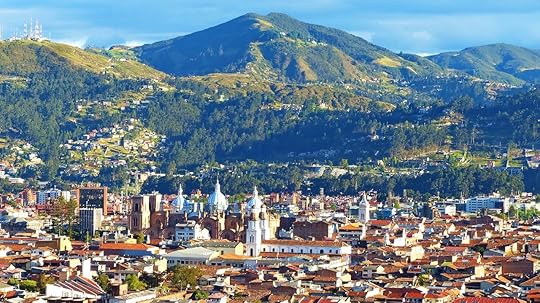
Ecuador is not a large country. The nation, which sits on South America’s Pacific coast, is about the size of Nevada. But packed into that small land area are distinct regions that offer vastly different experiences for tourists. In a few hours, you can go from island to beach to snow-capped mountain to lush rainforest — thanks to Ecuador’s expansive bus system and reliable puddle jumpers. This geographic diversity, along with bustling cities and rich pre-colonial history, makes Ecuador a great bang for your tourist buck. Here’s where to go in Ecuador depending on your vacation goals.
Four fascinating regions

Photo: Ecuadorpostales/Shutterstock
Ecuador’s four distinct regions include La Costa to the west, which provides stunning beaches and amazing seafood. La Sierra, which splits the country longitudinally, features the Andes Mountains and an insane number of volcanoes. To the east, El Oriente encompasses the country’s share of the Amazon. Finally, less than a mile off the coast sits the famed Galapagos Islands.
Sun and surf — Montañita

Photo: Diana Zuleta/Shutterstock
Recognized as a global surfing destination by World Surf Cities Network, Montañita draws surfing talent from around the world for its serious waves, but casual riders and non-surfers will find plenty to love about the buzzing seaside town. Beach bars and clubs make Montañita a bit of a party scene with drinks flowing late into summer nights. If you’re in search of some quiet suntanning, try finding accommodation along the coast, so you can pop in and out of town whenever you feel like partying or relaxing.
Ecotourism — Yasuní National Park

Photo: SL-Photography/Shutterstock
In the running for most biologically diverse place on Earth, Yasuní National Park sits on the far eastern edge of Ecuador in the Amazon basin. It combines ecosystems from the Andes, Amazon, and equator into one mishmash of wildlife and plants. The Napo Wildlife Center and Sani Lodge both manage wastewater to keep from contaminating the beautiful swampland. Napo runs on solar energy while Sani has low-impact nature trails, so both offer ways to visit the unique area and feel good about it.
Self care — Papallacta

Photo: Roberto Michel/Shutterstock
A short trip from the capital of Quito you’ll find Ecuador’s highest town perched high in the Andes at nearly 11,000 feet above sea level. Nearby Antisana volcano supplies Papallacta with plenty of natural hot springs perfect for soothing your tired muscles and stress-addled brain. The best of the bunch is Termas de Papallacta, a luxury hotel sporting the most beautiful hot pools in town.
Food — Cuenca

Photo: Stefano Barzellotti/Shutterstock
You can find many fantastic restaurants and street eats in Quito or Guayaquil, but for a truly unique taste of Ecuador, head to Cuenca, where you’ll find a regional specialty that’s rare outside the country. Cuy, or roasted guinea pig, is an unconventional treat for most visitors. Street vendors and restaurants usually spit roast the animal, hack it into quarters, and deliver it to diners head and all. It may be unnerving at first, but one bite of the shatteringly crisp skin and succulent meat will sell you on the unique meal.
Outdoor adventures — Baños

Photo: Fotos593/Shutterstock
Baños, or properly Baños de Agua Santa, lies on the border between the rainforest and the mountains. Situated at the base of the Tungurahua volcano, the town is named for its relaxing hot springs, but Baños is actually great for more active vacationers as well. Book an excursion from the town out into the nearby wilderness to zip line over lush ravines, scramble up and down flowing waterfalls, and hike the dramatic mountaintop forests.
Historic ruins — Ingapirca

Photo: LuminatePhotos by judith/Shutterstock
Machu Picchu in neighboring Peru gets all the attention, but Ecuador has plenty of Incan ruins as well. Ingapirca, in the Cañar province of mountainous La Sierra, is the largest Incan site in the country, and it tells a story totally unique to the ancient peoples of Ecuador. While it features the same architectural mastery of more famous Incan ruins, Ingapirca differs in that it’s actually the product of two peoples, the Inca and local Cañari, who merged peacefully to form a single society there. The main draw at Ingapirca is the Temple of the Sun, which was positioned to catch the sun in its entranceway during solstices.
Animal watching — Galapagos Islands

Photo: BlueOrange Studio/Shutterstock
It’s hard to beat the Galapagos for rare wildlife. You can find giant tortoises at breeding centers on multiple islands in the chain, along with wild penguins, marine iguanas, and albatrosses. To get there, take a small plane from Guayaquil to Baltra Island. Then grab a ferry to Santa Cruz Island and make your way to Puerto Ayora, where you’ll find cruises of various sizes and lengths that will take you throughout the island chain. All of this traveling can add up in both time and money, so if you’re on a budget, consider Isla de la Plata, known as the “poor man’s Galapagos.” Isla de la Plata features its own rich ecosystem, including the famous blue-footed booby, and sits just 90 minutes off the coast by boat. 

More like this: 10 things you can do in the Galapagos Islands other than look at tortoises
The post Ecuador packs the most adventure into a small space better than anywhere else in South America appeared first on Matador Network.

Reasons to visit Piraeus, Greece

On your visit to Greece, there’s a good chance you’ll pass through Piraeus. There’s an equally good chance you won’t slow down to check out this port city, using it instead as a throughway between Athens and the Greek Islands as do millions of tourists each year. But Piraeus has more to offer than its busy boat docks and traffic jams. It has picturesque neighborhoods, hilltop restaurants with amazing views, and some of the most incredible seafood the country has to offer. Here’s why Piraeus should be a stop, not a pass-through, on your itinerary.
You can admire fancy yachts at Pasalimani.

Photo: Viacheslav Lopatin/Shutterstock
A short jaunt from Piraeus’s main port you’ll come across a small scenic harbour, typically filled with fancy yachts gently swinging at the docks. Zea Harbor, or Pasalimani as locals call it, is known for being the cosmopolitan side of town, an engaging neighborhood lined with tavernas, cafes, and restaurants spread out across the oceanfront.
Pasalimani is the place to head for a leisurely afternoon walk or a romantic dinner by the sea. Opposite the harbor where the Stone Clock stands, a small square is a typical meeting point for younger people starting their evenings soon after the bars open their doors. At the west end of the harbor you’ll find Zea Marina, a famous docking spot for high-end luxurious vessels. Further down the way, the city’s Hellenic Maritime Museum is a good destination for your shore-side stroll.
Mikrolimano buzzes with cocktail bars.
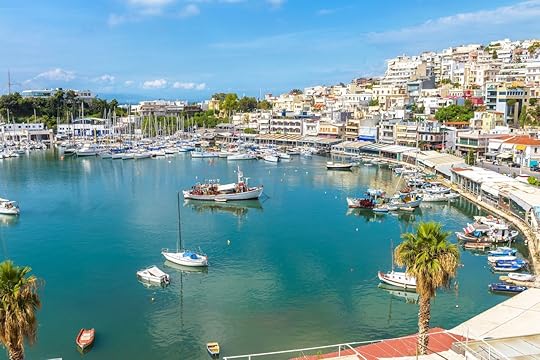
Photo: Viacheslav Lopatin/Shutterstock
Only a few minutes away from Pasalimani you’ll find Mikrolimano, which means “small port” in Greek. It’s an old traditional harbor that might not be as large or as lush as Pasalimani, but some would argue it’s twice as charming. Here, fancy yachts give way to tiny fishing boats, and posh cafes become traditional tavernas.
Mikrolimano is also the place for high-quality seafood, with several restaurants serving a variety of maritime delicacies at seaside tables with sweeping views. One of our favorite spots is Istioploikos restaurant, which serves up excellent local dishes alongside an unforgettable ocean view. And don’t let Mikrolimano’s laid-back afternoon atmosphere fool you. Come sundown, the harbor turns into a nightlife hotspot with fish joints ceding the attention to hopping cocktail bars.
Seafood is a cultural experience.

Photo: rawf8/Shutterstock
Piraeus has been a fisherman’s town for countless generations, something you’ll gather as you walk by the docks. Your culinary experience should start at a traditional tavern filled with locals rather than a sophisticated restaurant packed with tourists. You may not understand the menu, but there’s no reason to panic. Many tavernas offer a more passive experience. In most cases, there is no menu, and the waiters tell you what you want to order as a fresh catch of fish comes in daily, and that’s what’s on offer.
You’ll know you’re in the right place by the dim lights, huge wooden wine barrels that serve as decor, and the strong smell of calamari in the air. There’s also the telltale sound of 1950s Greek music on the speakers; these tavernas aren’t much for modern jams. You’ll be surprised to find out how linguistic barriers seem to vanish as owners are known to fill your glass with red wine and spark a lengthy hand gesture conversation.
The museums are unique.
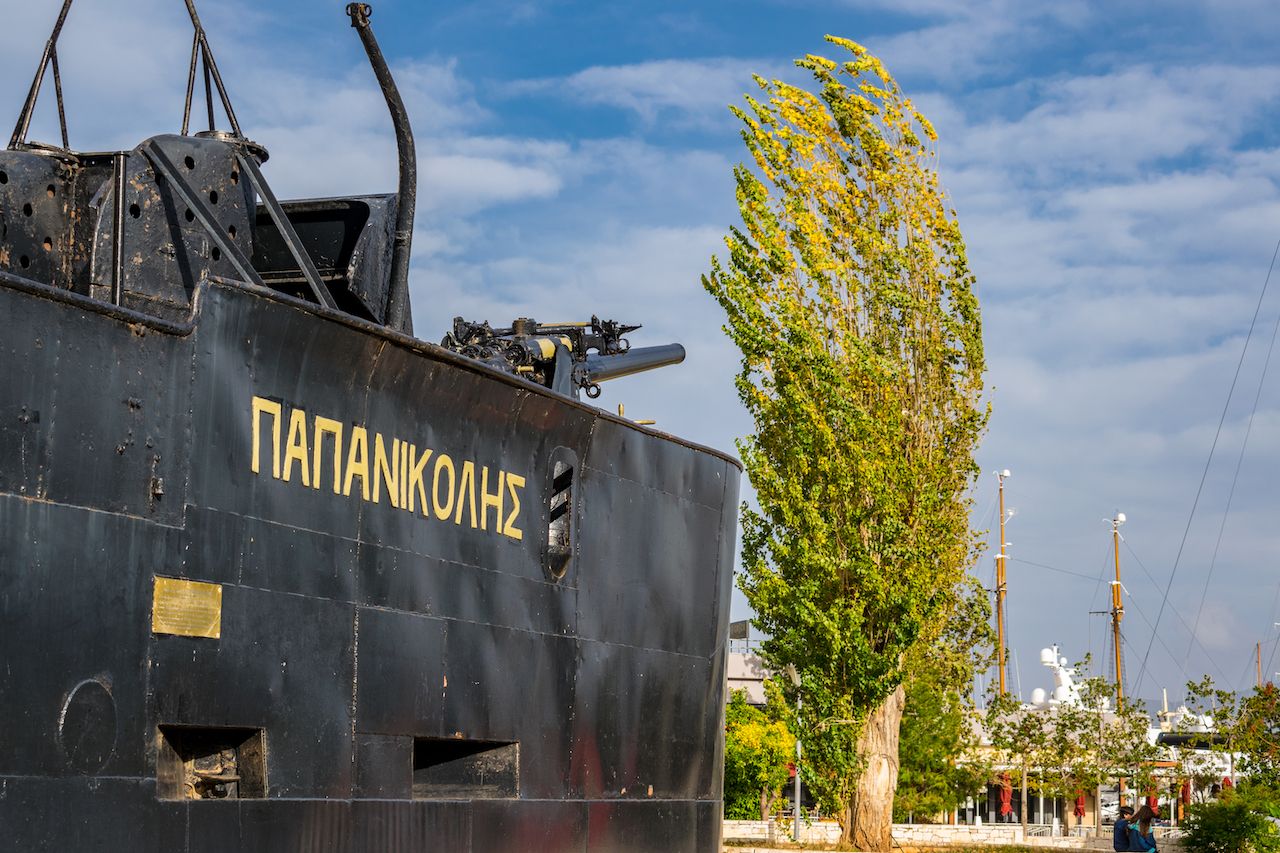
Photo: Nikolaos Tamvakis/Shutterstock
Even though they’re often overlooked by visitors, Piraeus is home to some of the country’s most unique museums, which reflect the region’s maritime history and rich culture. Of course, as is the case with most Greek destinations, the most famous among them is the Archaeological Museum. Housed in a two-story building, this institution features excavation findings sorted into chronological order in 10 different rooms, starting from the Mycenaean and Minoan eras.
The Hellenic Maritime Museum is dedicated to maritime traditions and highlights the city’s naval spirit and maritime activities through maps, flags, photographs, and century-old logbooks. Lastly, the Electric Railway Museum, founded in 2005, was a labor of love for a former railway worker. In collaboration with the railroad company, this retired railman gathered thousands of items — including old tickets, photographs, leaflets, and even an old carriage — that are now exhibited in this small space next to the train station.
Authentic neighborhoods offer stellar views.

Photo: trabantos/Shutterstock
Just above the small harbor of Mikrolimano you’ll find the hilltop district of Kastella, an authentic Greek neighborhood full of bright colors and cozy cafes. Its narrow streets and small-town atmosphere will make it hard to believe that you are still in the city and not on some tiny Aegean island. Take some time to explore the little shops, admire the neo-classical architecture, and savor the vista from Prophet Elias Church that stands majestically on top of the hill. At one of the balconies overlooking the bay, try the local favorite drink: an ice-cold cappuccino with cinnamon or chocolate.
The Sunday flea market holds a treasure trove.

Photo: Alin Popescu/Shutterstock
If you’re lucky enough to be in Piraeus on a Sunday with good weather, make sure to take a stroll through the flea market that takes place right next to the train station. Hone your bargaining skills and get ready to dig deep for records, jewelry, books, electronics, small furniture, and anything else that could become the best souvenir you’ve ever brought home. The flea market can usually be quite hectic, as there are numerous vendors, street food stalls, and sometimes hundreds of visitors.
On the nearby island of Agistri, you’ll find an oasis of calm.

Photo: Aerial-motion/Shutterstock
Tell any local that you’ve had enough of the city’s hustle and bustle and they’ll each give you the exact same advice: visit Agistri. The tiny isle in the Saronic Islands boasts turquoise waters, sandy beaches, and awesome diving spots. You’ll also find great food and peaceful villages.
In stark contrast to Piraeus and Athens, the tranquil atmosphere and easygoing attitude will have you believing that you magically transported to the Caribbean. And the best part about it is that it’s only about an hour away from Piraeus, with ferry boats departing five times a day. If you need to recharge your batteries, a day excursion to Agistri is guaranteed to do the trick. 

More like this: Why the Greek city of Thessaloniki needs to be on your radar
The post Why you should take some time to explore Piraeus on a trip to Greece appeared first on Matador Network.

Smithfield market in London

The Smithfield district of London is famed for its meat market, its architecture, and its rich history as a centerpiece for conflict — often surrounding religion but sometimes focused on football. It’s also one of the most underrated neighborhoods of London. For anyone interested in London’s macabre past, Smithfield delivers in droves. Apart from the bloody meat market, Smithfield offers everything from famous execution sites to haunted buildings, as well as some of the best preserved historic buildings in the city. Because Smithfield is more of a business center today, there are hardly ever any tourists checking out these interesting sites. However, due to the Crossrail developments and redevelopment of Smithfield Meat Market, the area is undergoing change and may not stay secret for long. For now, use its under-the-radar status to your advantage, and get to know one of the last vestiges of old London.
Visit the historic, once dangerous, Cloth Fair street.
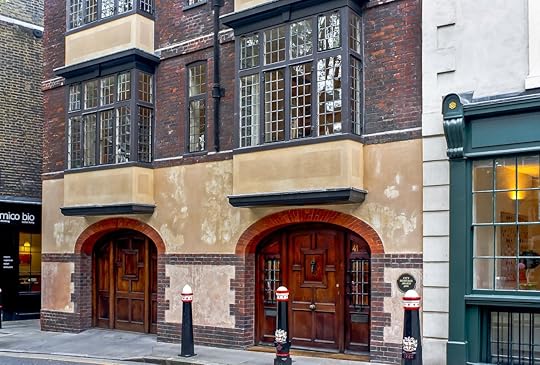
Photo: Edward Haylan/Shutterstock
The area around Smithfield is crisscrossed by narrow alleyways and streets, all of which have a story to tell. In Cloth Fair, one of London’s oldest streets, medieval traders gathered to sell material during the historic Bartholomew Fair, one of the city’s preeminent charter fairs. If you aren’t up on the lingo of the Middle Ages, a charter fair is a dressed up street market originally established by the British Royal Charter. Later, Huguenot weavers worked in the tightly packed buildings, and the poet Sir John Betjeman even lived in the area at number 43 Cloth Fair, which you can see marked with a blue plaque on your visit. As you pass by you’ll notice a quirky window on the building, called The Sailor’s Homecoming and built in the Trompe D’Oeil fashion — meaning its design is made to appear three dimensional, though it won’t actually jump out at you. But the street also has a dark side. In the early 19th century, the Rising Sun Pub was used by body snatchers, thieves guilty of exactly what the name suggests. Surgeons from the adjacent hospital needed bodies for dissection, and as such a lucrative trade went on here.
Hit the Smithfield Meat Market before the crack of dawn.

Photo: Daniel Avery/Shutterstock
There’s a smell of sawdust around Smithfield Meat Market — the largest meat and poultry market in Europe. It’s a sight to behold, but be ready to wake up super early. The market is open from 2:00 AM on weekdays — you read that right — and closes once trading is done at 7:00 AM, which is also when many traders head off for breakfast in the neighboring streets. The Victorian building is a celebrated landmark in the area, and if you want to get in and snap some photos you’ll need to be there well before closing. Hope you love the smell of raw beef in the morning.
Tuck into a local pub and former kangaroo court.

Photo: Hand and shears/Facebook
Today, the cozy watering holes of Smithfield are perfect places to stop for a pint, but they’re not immune from a dark past either. The quaint Hand and Shears dates back to the 1100s and is named for the cloth workers who would gather there before the St. Bartholomew’s Fair. Its upstairs is also believed to be the site where a temporary court would deliver swift justice to petty criminals, which, given its proximity to the fair and its unsavory characters, there were probably many of. The pub was also allegedly the spot of choice for revelers to enjoy a drink before a public hanging at nearby Newgate Prison — a popular form of entertainment back then.
Indulge your Black Death curiosity at the Charterhouse.

Photo: DRG Photography/Shutterstock
During the years of the Black Death, the area around Charterhouse Square was a plague pit. A monastery was built here in 1371, though during the Reformation years of the 16th and 17th centuries, this sanctuary was destroyed and the Charterhouse became a manor house where Lord North entertained Elizabeth I. Later, the building was a school, and the cloister is the place where soccer’s offside rule was defined. Today the Charterhouse is an almshouse for “men of good character,” and both the building and the museum are open to the public. Within the museum is a 14th-century skeleton of a plague victim, excavated locally. You can book a tour either with a professional guide or with one of the onsite men of good character, who will give an insider’s look into life in this historic building. These are highly recommended and are best booked online in advance.
See one of London’s most important hospitals, and the site of Sherlock’s “Final Problem.”

Photo: Edward Haylan/Shutterstock
One of the most defining buildings in Smithfield is St. Bartholomew’s Hospital. This is the oldest one in England and dates back to 1123. The famous gatehouse has the only statue of Henry VIII in London and there’s a small museum just inside the gate which is free. It contains a tribute to Sir Arthur Conan Doyle who wrote some of his Sherlock Holmes stories when studying medicine here. There’s also the small parish church of St. Bartholomew the Less within the grounds. The hospital facade itself opens out onto a magnificent square with blocks designed by James Gibbs and a massive fountain as the centerpiece. This is the hospital where William Harvey first discovered the circulation of the blood, and has been at the forefront of many pioneering medical developments in its almost 900-year history.
Speaking of Holmes, the hospital was also the filming location for the most harrowing and critically-acclaimed episode of the BBC’s Sherlock, “The Reichenbach Fall.” Spoiler alert: the hospital’s roof is where the final showdown between Moriarty and Sherlock takes place, where both characters fall to their deaths — one more permanent than the other.
Commemorate one of history’s most infamous executions.

Photo: Kiev.Victor/Shutterstock
While today there’s just a parking lot and a park, the walls outside of St. Bartholomew’s Hospital give a clue to the somber history of this area. In medieval times this was a place of jousting, fairs, and public executions. William Wallace, who fought for Scottish independence, was executed here in 1305. If you’ve seen Braveheart, you know that he was brutally hanged, drawn, and quartered (the actual execution was in fact way more gruesome, so he probably was unable to defiantly shout “freedom” or even given the opportunity to negotiate a quicker death). There’s a memorial to Wallace on the wall of the hospital. Alongside it is a plaque in memory of the many Catholic martyrs who were burned at the stake at Smithfield in 1546, during Henry VIII’s break with Catholicism. Even today, the area is reputed to be haunted after dark.
Across the road, there’s also the historic church of St. Bartholomew the Great, which has been featured on the big screen many times. Rahere, an Anglo-Norman monk beloved by King Henry I, founded an Augustinian priory here in 1123 along with the famous St. Bartholomew’s Hospital. Today, it has one of the best surviving Norman interiors in London and is a very atmospheric church, which can be entered through a timbered Tudor frontage. In the Lady Chapel, Benjamin Franklin once worked as a printer. Rahere’s tomb is also within the church.
Quietly reflect at Postman’s Park.

Photo: chris.dorney/Shutterstock
Make your way down King Edward Street and you’ll come to Postman’s Park. This tranquil setting contains something very special — the Memorial to Heroic Self-Sacrifice. This is a public monument containing 54 plaques with the stories of ordinary people who gave their lives to save others. It is a peaceful, contemplative place within London that many tourists overlook. But this, like the other areas in Smithfield, is full of stories with a rich historical heritage. 

More like this: 7 most fascinating dark tourism destinations around the world
The post Smithfield’s dark, grizzly past makes it the most fascinating district in London appeared first on Matador Network.

Vegan and vegetarian food in NYC

One of the best things to do in New York City is eat. Foods like bagels, deli sandwiches, pizza, and the like will forever be intrinsic to the city’s culinary history. But a lot of these can be heavy on meats and dairy products. Thankfully, a rapidly growing plant-forward scene is making such cuisines accessible to those who couldn’t eat them previously. NYC is actually the most vegan- and vegetarian-friendly city according to a 2018 study done by WalletHub, based on metrics such as affordability, vegetarian lifestyle, and diversity/accessibility/quality. Here are seven delicious vegan and vegetarian restaurants that you absolutely need to eat at.
1. Seasoned Vegan

Photo: Seasoned Vegan/@reinspired/Facebook
Soul food is known for its hearty dishes; its key components are vegetables, grains, and, of course, meats such as chicken, pork, and fish. Even dairy appears to be a necessary ingredient in dishes such as macaroni and cheese, grits, and hush puppies. It seems like a type of cuisine where a vegetarian or vegan would have a hard time finding something they could eat, but Seasoned Vegan is changing the game. Its tagline reads, “The food you love, veganized,” and it definitely lives up to that. Meat is substituted with soy here, and menu items include the locally beloved chopped cheese sandwich, barbecue riblets, and crawfish. If you’re visiting for brunch, be sure to try the soy fried chicken and pancakes — you won’t even notice the difference.
Where: 55 St Nicholas Ave, New York, NY 10026
2. Bodhi Kosher Vegetarian Restaurant
Bodhi is the first-ever vegan dim sum restaurant, spinning a vegan twist on traditional Chinese dishes. The extensive menu has so many options, ranging from appetizers like beef jerky and shiitake mushroom duck to main courses like lamb stew and steak. It’ll take you a while to decide what to order but whatever you get, you won’t have any regrets. All food here is kosher, as well, and there are also gluten-free options available.
Where: 77 Mulberry St, New York, NY 10013
3. Haab

Photo: Haab
Mexican cuisine staples include corn, chile peppers, beans, and tomatoes. With the Spaniard conquest came the introduction of different livestock, such as cows, pigs, and sheep. The cuisine that predates what is now Mexico was essentially vegan to begin with, and Haab in Brooklyn brings that to the forefront. It serves authentic Mexican food with meat and dairy, but it also has a menu without either of those. You can try the seitan chilaquiles with lettuce, avocado, onions, vegan cream, and sauce. Or spring for the traditionally cheesy nachos made instead with soy cheese, beans, seitan, guacamole, jalapenos, pico de gallo, and vegan cream.
Where: Two locations in Brooklyn
4. Orchard Grocer
Delis are as much a part of the history of New York City as anything else. Some of the best-known ones are Katz’s Delicatessen, Carnegie Deli, and Second Avenue Deli. While a new kid on the block, Orchard Grocer is an all-vegan deli and food market that pays homage to the NYC delis of old. Classic sandwiches are reimagined with ingredients such as tofu, seitan, and soy instead of animal products; there’s The Edith, a bagel with house-made cashew cream cheese and carrot lox, and The Marlowe, a Reuben with beet-brined Blackbird seitan. Shelves are stocked with specialty and organic items, all vegan, gluten, and palm oil free.
Where: 78 Orchard St, New York, NY 10002
5. Vinnie’s Pizzeria

Photo: Vinnie’s Pizzeria/Facebook
This unique Brooklyn pizzeria has attracted the attention of many in the past few years, and for good reason. One of its most famous creations is the pizza-box pizza, a pizza within a pizza box made out of pizza. The menu goes beyond the standard toppings of cheese and pepperoni and brings in a whole slew of vegan and vegetarian options, ranging from pico de gallo to breaded eggplant. There’s a list of specialty pies for each, as well, like the vegan Tiger Style with teriyaki “chicken,” broccoli, sesame seeds, and mozzarella and cheddar substitutes.
Where: Two locations in Brooklyn
6. Cinnamon Snail
Cinnamon Snail began as a food truck in 2010 and now has two permanent locations in Manhattan — one in the Financial District and the other in a Midtown food hall. Its menu is entirely vegan and kosher, and you can order breakfast foods, sandwiches, salads, and burgers. If you still have room after a Beastmode Burger Deluxe or cashew cheese tater tots, be sure to try a doughnut or two from the rotating 30-flavor list.
Where: Two locations in Manhattan
7. Champs Diner

Photo: Champs Diner/Facebook
Diners are another quintessential part of the food scene in the United States, and NYC’s got them aplenty. There’s no need to stick to the salad menu if you’re a vegan or vegetarian because at Champs it’s all vegan, all the time. Expect standard diner fare but with a twist — like the s’mores pancakes and the Kickin’ Cowgirl tofu scramble with tofu, tater tots, chili, cheese, avocado, and toast. We recommend trying one of 10 different milkshakes offered, such as the Girl Scout with vanilla ice cream, mint, cookie crumbles, and whipped cream.
Where: 197 Meserole St, Brooklyn, NY 11206 

More like this: The 5 best winter getaways from New York City
The post Where to eat in New York City if you’re vegan or vegetarian appeared first on Matador Network.

Disney’s ‘Star Wars’ ride to be long

If you feel like the lines for amusement park rides are always longer than the rides themselves, you won’t have to worry about that with Disneyland’s new Star Wars ride. Located inside Disney’s newest land, Star Wars: Galaxy’s Edge, the ride called Star Wars: Rise of the Resistance, is a lengthy experience designed to fully immerse guests in the story of the Resistance and the First Order. On her podcast Theme Park Stop, Alicia Stella, writer for the Disney and More blog, reveals that the ride features over 300 animatronic figures, and estimates that it could run for as long as 28 minutes.
In the teaser video (above), Scott Trowbridge, studio leader at Walt Disney Imagineering, calls the ride “the most epic attraction we’ve ever built.” And by the looks of it, he’s right. Guests begin the ride on the Star Destroyer, and are then taken prisoner by the First Order before members of the Resistance come to save them on trackless vehicles. “This attraction invites you to be a recruit to the Resistance and stand up against the First Order,” said Trowbridge. “And you even come face-to-face with Kylo Ren. You make it through that, you get back to the planet, you’ll be a hero of the Resistance.”
If this sounds like enough action to fill a feature film, it’s because it almost is. Given the detailed experience and wide breadth of the storytelling, it’s no surprise this ride is expected to run nearly a half-hour long. While no specific date has been set, Rise of the Resistance will open when the Star Wars park itself opens this coming June. 
H/T: Travel & Leisure

More like this: Disney raises ticket prices before the opening of ‘Star Wars’ land
The post Disney’s premier ‘Star Wars’ ride is rumored to be 28 minutes long appeared first on Matador Network.

Underwater scuba diving theme park

Sinking decommissioned jumbo jets into the Persian Gulf is an unusual way of attracting tourists, but that’s what Bahrain is going for. The Kingdom of Bahrain is planning to create the world’s largest underwater theme park, a 1,076,391-square-foot dive site, complete with a sunken Boeing 747, art sculptures, a replica Bahraini pearl merchant’s house, and artificial coral reefs.
The dive park, set to open in summer 2019, is Bahrain’s latest attempt to grow its tourism economy, by making the country a premier diving destination in the region.
In response to concerns that the dive site might not be eco-friendly, a spokesperson told CNN Travel that “all aircraft surfaces will be subjected to a high-pressure wash with bio-friendly detergents to ensure all post-production coatings, oil, and grime are removed. Furthermore, a vast amount of time has been spent removing contaminants from the aircraft. This has included removing all wiring, all hydraulic, pneumatic, and fuel systems, as well as all adhesives, insulation, plastics, rubbers, chemicals, or other potential toxic substances.” But concerns remain about the leaching of heavy metals in the sea water and the safety issue linked to the corrosion of the structure.
As monumental as this project may be, Bahrain isn’t the first to sink an aircraft to create a diving site. A sunken 727 in Mermet Springs, Illinois featured in the 1990s movie US Marshals now acts as a popular dive site. There is also an old 737 in the Stuart Channel off Chemainus in British Columbia, which divers can explore, and Turkey lowered an Airbus jet into the Aegean coast, to serve as an artificial reef in 2016. 
H/T: Insider

More like this: How to go SCUBA diving without being certified
The post Bahrain is sinking a Boeing 747 and turning it into an underwater theme park appeared first on Matador Network.

Matador Network's Blog
- Matador Network's profile
- 6 followers



